
1. Strategy Implementation
1.1. HRM Practices
1.1.1. Job Analysis and Design
1.1.1.1. the process of getting detailed information about jobs. Job design addresses what tasks should be grouped into a particular job. (*Job is the group of many tasks to be performed
1.1.2. Employee Recruitment and Selection
1.1.2.1. Recruitment
1.1.2.1.1. the process through which the organization seeks applicants for potential employment
1.1.2.2. Selection
1.1.2.2.1. the process by which it attempts to identify applicants with the necessary knowledge, skills, abilities, and other characteristics that will help the company achieve its goals
1.1.3. Performance Management
1.1.3.1. used to ensure that employees’ activities and outcomes are congruent with the organization’s objectives.
1.1.4. Pay Structure, Incentives, and Benefits
1.1.4.1. a high level of pay and/or benefits
1.1.4.1.1. competitors can ensure that the company attracts and retains high-quality employees
1.1.4.1.2. might have a negative impact on the company’s overall labor costs
1.1.4.2. tying pay to performance, company can elicit
1.1.4.2.1. specific activities
1.1.4.2.2. levels of performance from employees.
1.1.5. Labor and Employee Relations
1.1.5.1. Whether companies are unionized or not, the general approach to relations with employees can strongly affect their potential for gaining competitive advantage.
1.2. Strategic Types
1.2.1. overall cost leadership
1.2.1.1. Focuses on becoming the lowest cost producer in an industry.
1.2.1.2. achieved by constructing efficient large-scale facilities
1.2.2. differentiation
1.2.2.1. create the impression that the company’s product or service is different from that of others in the industry.
1.2.2.2. The perceived differentiation can come from creating a brand image, from technology, from offering unique features, or from unique customer service.
1.3. HRM Needs in Strategic Types
1.3.1. Different strategies require employees with specific skills and also require these employees to exhibit different “role behaviors.
1.3.2. Role behaviors are the behaviors required of an individual in his or her role as a jobholder in a social work environment. These role behaviors vary on a number of dimensions.
1.4. Directional Strategies
1.4.1. Concentration Strategies
1.4.1.1. require that the company maintain the current skills that exist in the organization
1.4.2. Internal Growth Strategies
1.4.2.1. present unique staffing problems. Growth requires that a company constantly hire, transfer, and promote individuals, and expansion into different markets may change the necessary skills that prospective employees must have.
1.4.3. Mergers and Acquisitions
1.4.3.1. Increasingly we see both consolidation within industries and mergers across industries.
1.4.4. Downsizing
1.5. Strategy evaluation and control
1.5.1. it is extremely important for the firm to constantly monitor the effectiveness of both the strategy and the implementation process
1.5.2. makes it possible for the company to
1.5.2.1. identify problem areas
1.5.2.2. revise existing structures and strategies or devise new ones
2. The Role of Human Resources in Providing Strategic Competitive Advantage
2.1. Emergent Strategies
2.1.1. Intended strategies
2.1.1.1. the result of the rational decision-making process used by top managers as they develop a strategic plan
2.1.2. Emergent strategies
2.1.2.1. a pattern of action that develops over time in an organization in the absence of a specific mission and goals, or despite a mission and goals.
2.2. Enhancing Firm Competitiveness
2.2.1. A related way in which human resources can be a source of competitive advantage is through developing a human capital pool that gives the company the unique ability to adapt to an ever-changing environment.
3. Intro
3.1. Business Model
3.1.1. a story of how the firm will create value for customers and, more important, how it will do so profitably
3.2. Strategic Management
3.2.1. a process, an approach to addressing the competitive challenges an organization faces.
3.2.2. Strategies
3.2.2.1. the generic approach to competing
3.2.2.2. the specific adjustments and actions taken to deal with a particular situation
3.2.3. Components
3.2.3.1. Strategy Formulation
3.2.3.1.1. decide on a strategic direction by defining the company’s mission and goals, its external opportunities and threats, and its internal strengths and weaknesses -> generate various strategic alternatives and compare those alternatives’ ability to achieve the company’s mission and goals.
3.2.3.2. Strategy Implementation
3.2.3.2.1. follows on the chosen strategy
3.2.4. Linkage between HRM and the Strategic Management Process
3.2.4.1. The strategic choice really consists of answering questions about competition—that is, how the firm will compete to achieve its mission and goals.
3.2.5. COMPETING THROUGH TECHNOLOGY
3.2.5.1. Four levels of integration
3.2.5.1.1. administrative linkage
3.2.5.1.2. one-way linkage
3.2.5.1.3. two-way linkage
3.2.5.1.4. integrative linkage
4. Strategy Formulation
4.1. External analysis
4.1.1. examining the organization’s operating environment to identify the strategic opportunities and threats
4.2. Internal analysis
4.2.1. attempts to identify the organization’s strengths and weaknesses
